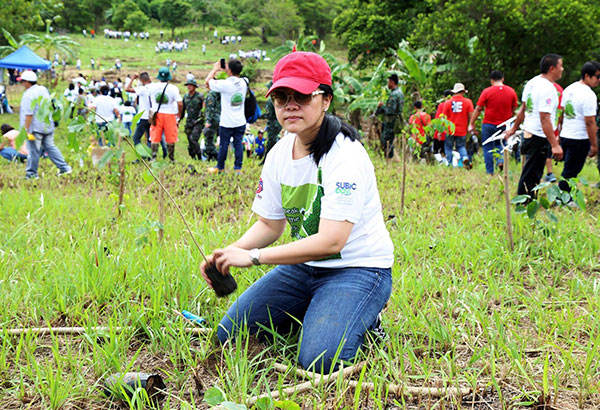SPECIAL REPORT; Philippines forestry: Who’s to blame for the mess?

Subic Bay Metropolitan Authority administrator and chief executive officer Wilma Eisma prepares to plant a narra seedling and lead employees during the Arbor Day tree-planting activity late last month at the freeport. Around a thousand volunteers from the SBMA, business locators and other groups planted some 5,000 trees during the Arbor Day celebration. Bebot Sison Jr.
(Conclusion)
“Nobody is blameless for the sordid state of the Philippine forests,” forestry expert Adolfo Revilla said.
He mentioned government leaders and lawmakers who for decades maintained a “giveaway price” policy for timber and other forest products that abetted forest exploitation.
“All forestry problems can be traced to this,” Revilla said.
The former university professor recalled that up to 1989, the forest charge for timber was a measly 1.5 to three percent of the log’s market value. The same is true with other forest products, including “free water” from the forestlands and watersheds.
The normal stumpage value of timber (for the stump/standing tree) should be 20 to 30 percent of the log’s market value. This would still translate to about 20 percent profit margin for the efficient logger, Revilla said.
Also to blame are the “lawless greedy,” mostly logging companies of old, with illegal loggers and tree cutters likely in collusion with the authorities. They destroyed the forest resources not only in the productive forests but also in critical watersheds, national parks and other protected areas.
Not entirely faultless are the millions of Filipinos who, owing to extreme poverty, have made the forests/uplands their home.
The general public also stood in utter apathy and indifference and thus virtually allowed the wanton destruction of forest resources.
As if destructive forest enemies were not enough, there emerged in recent decades another “mountain killer” – the irresponsible mining companies (not in Revilla’s book, rather an addendum from the recent congressional hearings on the mining issue).
Summing up, Revilla said: “The Filipinos, as a people – notably the leaders, forestry and other government officials, forest licensees, illegal loggers and tree cutters, and those who migrated to the forestlands – have been responsible for the degradation of the natural patrimony. The perpetrators played different roles in this inter-generational ‘crime’.”
One other chilling reality is that more than 20 million illegal mountain dwellers now call the uplands their home. Their number is projected to soar to 43.5 million by 2025.
Revilla conceded that it is “next to impossible” to remove these illegal migrants.
As a former DENR official once candidly admitted: “Poverty has driven millions of our people into the uplands, where they despoil the forest for subsistence. And yet because we are dealing with the poorest of the poor, we cannot find the moral strength to enforce the law strictly.”
Indeed, the country’s devastated forestlands, now just awaiting their “ecological doom,” continue to be littered with development programs that utterly failed.
With optimism not totally lost, Revilla stressed that even if “we are on the verge of losing what is left of our natural resources… we have not and should never give up hope of reversing the trend.”
The author pins his hope on a no-nonsense sustainable forestry program whose adoption and effective and efficient implementation demands the strongest political will that a nation can muster.
- Latest































